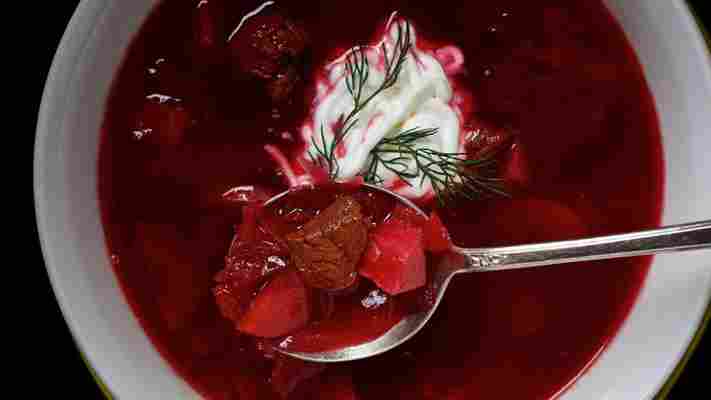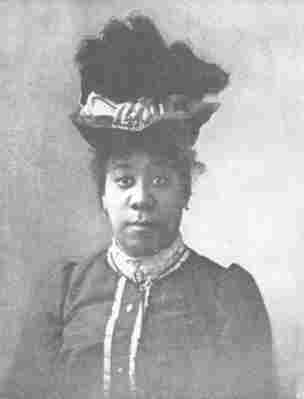Who really owns borsch?
Soup should never be your go-to weapon in a food fight. As projectiles go, a bowl of chunky liquid proves messy and lacks precision. Fist-size bread rolls are more effective – or, say, chocolate pudding catapulted from a spoon. In Russia though, the latest food fight is all about soup, and it’s being hurled from the walls of the Kremlin via Twitter.

The soup war boiled over into social media this year, when @Russia (the official Twitter account for the Russian Federation’s Ministry of Foreign Affairs) tweeted: “A timeless classic, #Borsch is one of Russia’s most famous & beloved #dishes & a symbol of traditional cuisine”.
To the average Twitter skimmer, Russians broadcasting about borsch may seem obvious and innocuous, but for Ukrainians, who consider borsch to be their national dish, the Russian tweet is wartime propaganda, especially considering the current occupation of Crimea and the latest territorial conflict in eastern Ukraine that’s been raging since 2014. The Ukrainian Twittersphere responded with anger and humour, with comments like “As if stealing Crimea wasn’t enough, you had to go and steal borsch from Ukraine as well”.

A war over who owns borsch has boiled over on social media this year (Credit: Denis Karpenkov/Alamy)
You may also be interested in: • The Cold War-era drink that rivals cola • How to drink vodka like a Russian • The truth about the humble French fry
Borsch (борщ in Cyrillic) is a hearty soup, usually coloured red from beetroot (though green and white varieties of the soup exist), and for centuries, it has been a daily staple in the Ukrainian kitchen. For many, Russia’s claim on such a quintessentially Ukrainian dish embodies a much larger trend of Russia’s historical oppression of Ukrainian language, politics, and, above all, independence.
According to Alex Kokcharov, a London-based political and economic risk analyst of Belarusian descent, the Russian Foreign Ministry’s chest-beating around “Russian” borsch is, “another attempt at cultural appropriation by Moscow”. He explained that while “a number of cultures claim borsch to be theirs – Ukraine, Belarus, Poland and Russia – Ukraine has the strongest claim for the dish.”
“Borsch is most definitely from Ukraine,” said Olesia Lew, a New York-based chef and head consultant for Veselka , the iconic Ukrainian diner in New York City’s East Village, who is proud of her Ukrainian heritage. “I say it’s Ukrainian, not just from a nationalistic point of view, but because the soup hails from the land of Ukraine, and those ingredients have been found in the country’s archaeological record into the distant past.”

Borsch is usually coloured red from beetroot (Credit: barbara cameron pix/Alamy)
So, what about the millions of ethnic Russians who insist the red soup they love is most decidedly Russian?
“Yes, Russian people claim it’s their food,” said Lew, “But it’s a food they developed through occupation.”
According to Lew, borsch did not simply leak across the collective consciousness of Russian cuisine, but most likely entered the Soviet mainstream in the Stalinist era as a result of a concerted effort by the Kremlin. In his attempt to collectivise the largest country on Earth, Stalin tasked his Commissar of Food, Anastas Mikoyan, with establishing a Soviet national cuisine that catered to the more than 100 different “nationalities” (the Soviet term for the diverse ethnic populations) found in the USSR.
Russian people claim it’s their food, but it’s a food they developed through occupation
Mikoyan’s official study of cultural melting pots and mass food production led him to the United States, where he fell in love with hamburgers, hot dogs and ice cream. On his return, Mikoyan launched factory-produced ice cream across the Soviet Union and popularised efficient kitchen meals like kotleti (minced meat patties) in everyday cooking. In 1939, he published the propaganda-heavy Book of Tasty and Healthy Food, a standardised cookbook that was often gifted to newlywed couples in the Soviet Union from the Communist Party – a book that is still in print to this day.
“Mikoyan needed to mass-produce a cultural identity for these Soviet foods,” said Lew. “It’s fascinating to read what he picked from each place – be it Ukraine or Georgia – while remaining vague (eg “add meat”), since at the time most ingredients were not widely available across the Soviet Union. The cookbook made all these dishes part of Soviet culture and thereby ‘Russian’, since Russia was the most important culture for the Soviets.”
While Russian people claim borsch as their own, it has been a daily staple in Ukrainian kitchens for centuries (Credit: Olga Nikiforova/Alamy)
So what exactly does this Soviet food bible say about borsch? Chapter 6 (“Soups”) starts with cabbage-based Shchi , listing six different recipes, after which comes “Borsch”, then “Summer Borsch” (featuring squash, celery and beetroot greens), followed lastly by a differentiated “Ukrainian Borsch”. (Imagine an American cookbook with multiple recipes for tacos, finishing with “Mexican tacos”, and that’s what it sounds like.)
According to Mikoyan’s recipe, standard borsch contains meat, beetroot, cabbage, root vegetables, onions, tomato paste, vinegar and sugar, while “Ukrainian” borsch contains meat, cabbage, potatoes, beetroot, tomato paste, carrot, parsnip, onion, bacon, butter, vinegar and garlic, garnished with sour cream and chopped parsley. The Ukrainian recipe, framed as a separate iteration of the standardised version, is by far the most well-known today.
While the broader world may consider borsch as a quintessentially “Russian” food, very few non-Russians are acquainted with the much less-exciting Russian variant shchi. As a basic cabbage soup, shchi is effectively borsch without the beetroot.
An 1823 Russian dictionary of Ukrainian words defined borsch as “the same thing as shchi”, while an 1842 book of Russian etymology differentiates between Russian shchi (referring to sour cabbage) and Ukrainian borsch, a word that in fact references the soup’s traditional ingredient of hogweed, or borschevik . Hogweed ( Heracleum sphondylium ) grows throughout Eurasia, but the plant flourishes in the marshy areas around the Danube and Dnipro (Dnepr in Russian) river deltas. Long before the modern-day countries of Russia or Ukraine existed, the people of the Black Sea region boiled soup from the pickled stems, leaves and flowers of the hogweed plant. Recipe books show that the Ukrainians added beetroot.
Borsch likely entered the Soviet mainstream when Stalin’s Commissar of Food, Anastas Mikoyan (right), established a Soviet national cuisine (Credit: TASS/Getty Images)
Similar-yet-separate culture and geography make the untangling of Russian and Ukrainian history an almost impossible task. Pro-Russian ideologues use the region’s complex past to promote a rewritten history that draws a straight line from the current Russian regime back to the original Slavic civilisation. To that end, in its tweet, the Russian Foreign Ministry doubled down on its historical bias by reframing of the origins of borsch from “Russian” hogweed that dates back to the “Ancient Rus” of the 10th Century.
The problem with this statement is that Ancient Rus was centred in Kyiv (Kiev in Russian), now the capital of Ukraine. Over the past millennium, Ukraine’s largest city has been defined by repeated invasion, occupations and violent uprisings – often against the stronghold of Russian influence over Ukrainian politics. Rebranding Ukraine’s national food staple as Russian is even more ironic and offensive in light of the Holodomor, Stalin’s manmade famine of 1932-33 , when forced collectivisation, aggressive grain procurement and confiscation of food stores led to the starvation of millions of Ukrainians. The exact number of dead, and whether the famine should be considered a genocide, remains a sticking point that is still debated and denied by Russians.
The cookbook made all these dishes part of Soviet culture and thereby ‘Russian’
The battle over borsch and its meaning continues online, most notably around the soup’s official definition. Ukrainian Wikipedia lists borsch as “found in Ukrainian, Belarusian, Polish, Lithuanian, Iranian and Jewish national cuisines,” but fails to mention Russian cuisine. Meanwhile, Russian-language Wikipedia says: “Borsch is a type of beet-based soup, giving it a characteristic red colour. A traditional dish of the Eastern Slavs, it is a common first course in Ukrainian cuisine.”
Admittedly, the wider, non-Slavic world views borsch as Russian, while Poles know it only as beloved Polish barszcz . This is also problematic since at least half of Ukraine was occupied by Poland for several centuries. Meanwhile, the common English spelling of borscht (with a “t”) derives from the Yiddish transliteration, since the soup was introduced to the west primarily by Jewish refugees fleeing Eastern Europe. Food travels with people, which is why borsch is now popular worldwide.
Mikoyan’s Book of Tasty and Healthy Food included recipes that catered to the more than 100 different ethnic populations in the USSR (Credit: Bernard Bisson/Sygma/Getty Images)
“The soup is everywhere now,” said Dima Martseniuk, head chef at Veselka. “Maybe like 5% of Russians say it’s theirs, but the other 95% know that borsch is Ukrainian. I mean, I’m not going to pick a fight over it.” More than nationalism, what matters to Martseniuk is how the soup tastes, since he makes and serves hundreds of gallons of borsch every week.
“My grandma’s classic recipe begins with pork stock boiled from rib bones. Then you have to use sweet cabbage – not the heavy kind. Then it’s important that you cook the other ingredients on the side, in a separate frying pan. You have to sauté them – the onion, carrot and shredded beetroot. Then you add sunflower oil, butter, spices, ketchup or tomato paste. And be sure to add something acidic – white vinegar or lemon juice – that helps preserve the deep red colour.”
His less-traditional tip? “Try making borsch in a pizza oven,” Martseniuk said. The open flame apparently does wonders to the cooking and it tastes really good.
The Book of Tasty and Healthy Food’s chapter on soups begins with shchi, which is effectively borsch without the beetroot (Credit: Vladislav Gudovskiy/Alamy)
Variation is the real beauty of borsch, and across Ukraine, I’ve encountered countless varieties of the soup – with or without meat, beans or certain spices.
“There are as many versions of borsch as there are Eastern European grandmas,” said Tom Birchard, owner of Veselka. “People have an emotional attachment to the soup, and everybody has their own idea of what it is.”
There are as many versions of borsch as there are Eastern European grandmas
I learned how to make borsch while living in Kharkiv, the second largest city in Ukraine less than 30km from the Russian border. My teacher, Tanya Karabanova, was a bona fide babulya (Ukrainian grandmother) who insisted that the best borsch came from careful cutting and separate cooking of each ingredient so that every subtle vegetable flavour comes out. She was adamant that I never chop the cabbage into squares, resulting in what she called “ stolovaya ”, or “cafeteria-style”, borsch – the kind of soulless, watery-brown sustenance ladled out in schools, military bases or prisons. Instead, she told me to “rotate the cabbage downwards while shaving finely along the edge, forming long, fine, crescents of translucent cabbage”.
“With borsch, everyone is right,” Lew explained. “Ukrainians are fiercely independent and defensive about their food and how authentic it is. For me, the key thing is to have the right beets – young, sweet summer beets. I’m a big fan of meatless borsch – and I like beans in my borsch because that’s the way I was raised. Sour cream, absolutely, and I like a bit of kvas (a fermented beverage) in the back note – the sour offsets the sweetness and richness of the beet.”
Ukrainian borsch, made with meat, cabbage, potatoes and beetroot, is by far the best-known version (Credit: Deb Lindsey For The Washington Post/Getty Images)
Lew buys her ingredients in the farmers’ markets of New York City, insisting on using the freshest ingredients. Descended from an immigrant family, Lew admits that like borsch, her own life story has spread across the globe.
“Food is part of culture and identity, but people move,” she said. “Food can be shared, and it can unite people – but food can travel. Things get sticky when you try to deny people the food that they have been raised on for generations, and I would never want to deny someone their cultural heritage simply because they were raised in Soviet times.”
Food Wars is a series from BBC Travel that invites you to feel the heat when passions flare around beloved dishes that shape a culture’s identity.
Join more than three million BBC Travel fans by liking us on Facebook , or follow us on Twitter and Instagram .
If you liked this story, sign up for the weekly bbc.com features newsletter called "The Essential List". A handpicked selection of stories from BBC Future, Culture, Worklife and Travel, delivered to your inbox every Friday.




Post a Comment